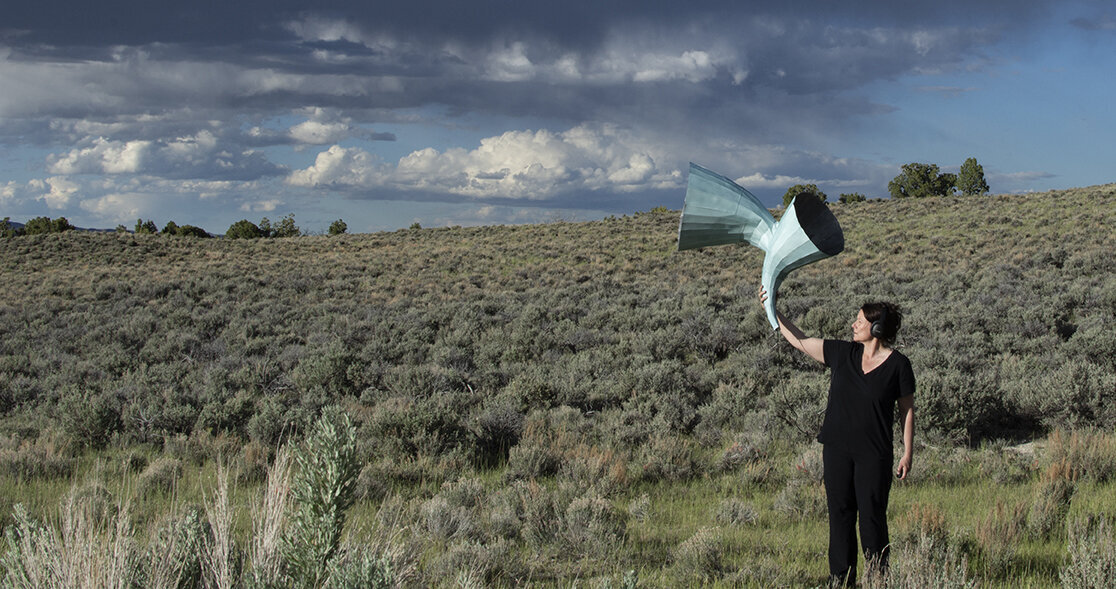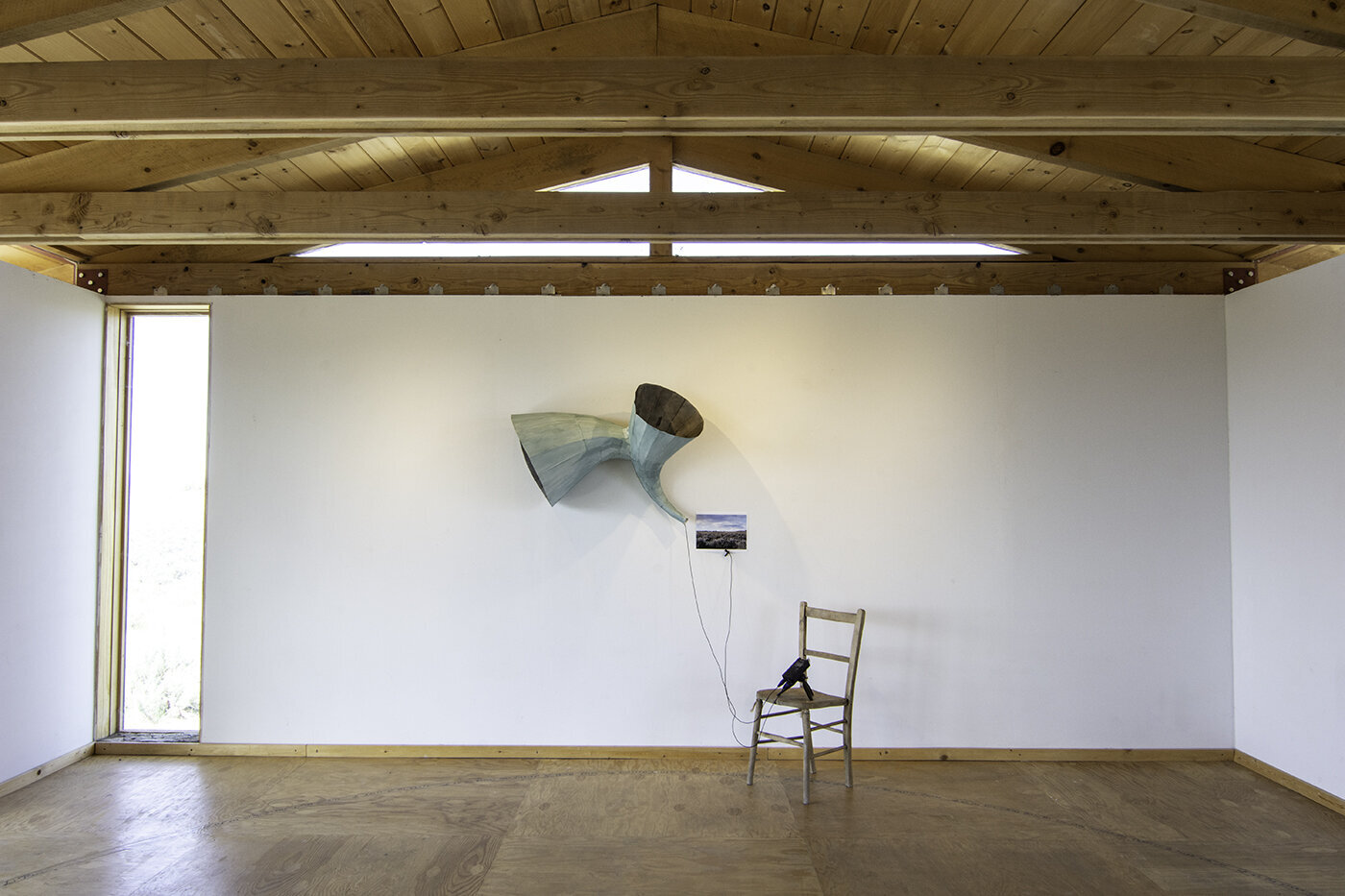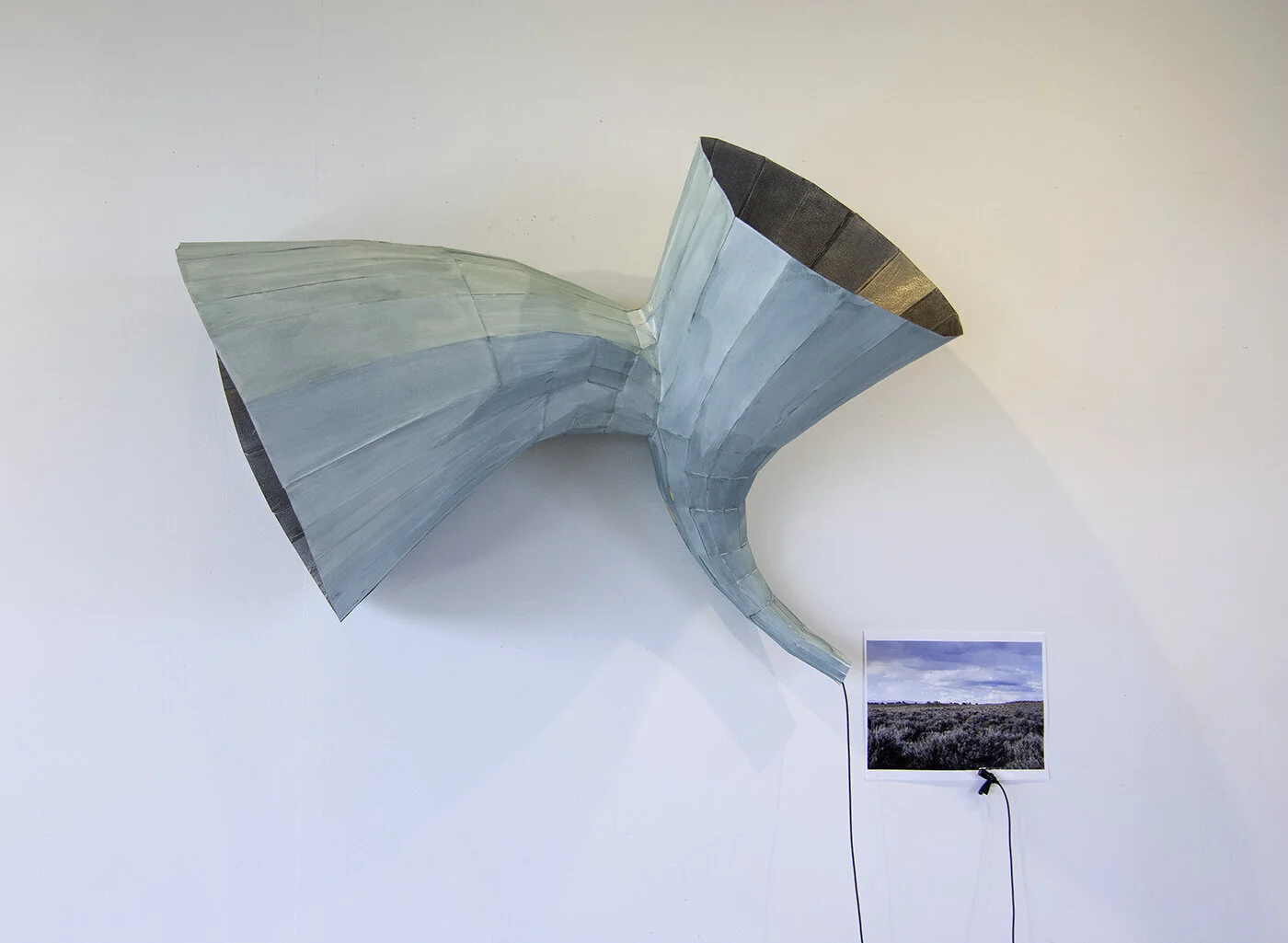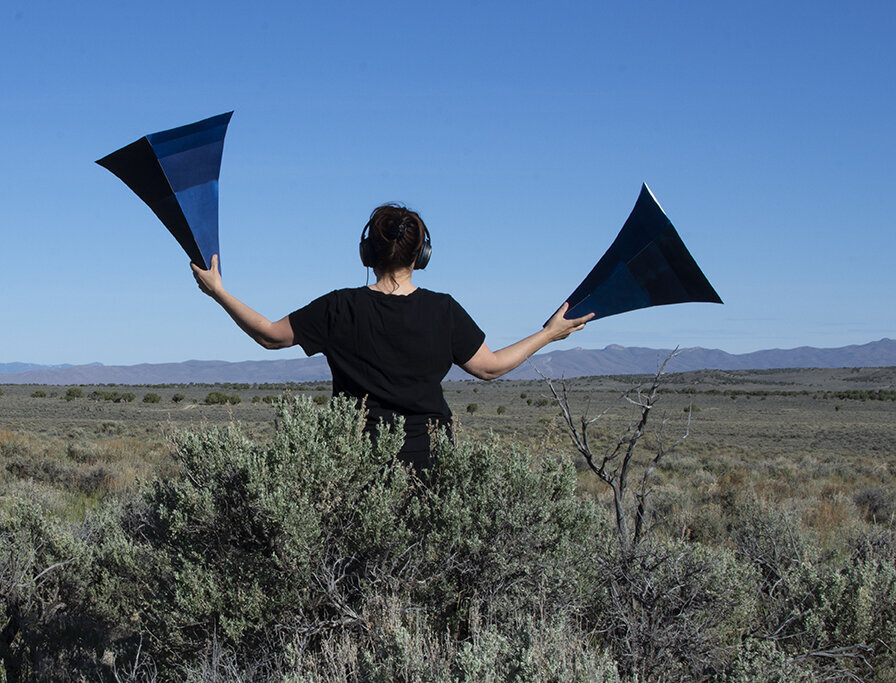Reflections from a Remote Desert Valley.
Photo/Stefan Hagen.
The Montello Foundation is a foundation dedicated to support artists who foster our understanding of nature, its fragility, and our need to protect it.
I was traveling through the wide-open spaces of Nevada in 2007, and I was taken like most travelers by the landscape’s beauty of gentle proportions and subtle colors. One might perceive this large expanse of visible landscape as primordial. It is desolate and empty, no one else around to the horizon. But then, the conscious mind, any conscious mind, remembers now the human responsibility for nature, in this particular place and in all nature.
This moment of recognition then took on for me a definitive, more precise purpose: to preserve a piece of this desert landscape, protecting this delicate system of flora and fauna, but then also, at the same time, to create a place in the sagebrush desert for observation, for contemplation, and for artistic work.
Out of this an idea has grown, that maybe through the creative means of artists, we can foster a greater respect for the desert and actually all nature…I first secured 80 acres of undeveloped land in an isolated valley in the Northeastern corner of Nevada. It is a valley where the mountains do have these gentle proportions, and the colors are wonderful subtle - with interspersed bright splashes of flowers, a valley near a village named Montello, and so this idea got its name: Montello Foundation.
Next came an extensive design process, to create a plan for the centerpiece of the Montello Foundation: a solitary retreat where artists can experience the vastness of a desert landscape from a safe building, a “base camp,” a unique space for inspiration and creation, a place that provides a shield from distractions in the solitude of the desert. During this process we were also very mindful of the need to minimize our impact on the environment with the construction.
The building is now complete…designed with a large shading roof under which there are two distinct spaces. One space is for the bodily needs: eating, sleeping, washing, and a stove for the cold desert nights, and a second space for work: for writing, painting, drawing, studying—a space for the first materializations of new ideas.
These materializations are an important part of what we would call our cultural scene, but we have to remember also the important part artists play in our society. We are constantly confronted with numbers describing climate change, deforestation, and the decline in species. But if just numbers could get us to act, the ads in magazines or on TV would be only figures and equations and an occasional graph, but figures and equations alone just don’t get us to act.
It is artists who are able to create this desire in us for a product, for a lifestyle. Here in this case, we want our community of artists and caring individuals to “advertise” the “product” called preservation.
The Montello Foundation’s main focus is to provide a solitary retreat in a remote desert valley. Located in the northeastern corner of Nevada near the village of Montello, the house is hidden away from asphalt roads and lights at night and especially cell phone reception. The idea behind the retreat is that you are in this incredible desert landscape all by yourself. There is no direct interaction with other humans, no staff or other artists, you don't have to be social, decide whether you go to your room, or chat all night.
In a way, this is ideal for a time when isolation is called for, but the major challenge is now of course the travel to the residency. While the majority of the residents are coming from the United States, we had to move residents from overseas to later in the year hoping they can travel then. Of the residents, few have taken it on to drive all the way from the East Coast.
But of course interaction is a vital part of being human and being an artist. Interaction with an audience is the artist’s focus throughout their entire process, from conception to presentation. An artwork does not exist as an artwork without an audience. This thought is in one way or the other on the minds of every artist now.
While this is right now everywhere an issue, the remoteness and lack of distraction at our retreat offers an opportunity to focus on a bigger picture, on the necessity of new directions and solutions for the society at large -- time and space works there in different dimensions.
In the following you will find two reports from our first residents this year, Ash Ferlito and Mia Mulvey.
Stefan Hagen, Founder
Photo/Stefan Hagen.
Harmonics, 2020, sage, dandelion, vetch, low larkspur, beardtongues, buckwheats, Indian paintbrush, logwood, madder and ruston muslin. Photo/Ash Ferlito.
How wonderful to spend a moment on earth at the Montello Foundation. An easy sidestep for me to make, out of the stream of influence and internet and into first light in the Juniper patch identifying birds. Sagebrush scented air, always – sometimes wet, sometimes dry, full of song. Listened to the chorus of sparrows, teasing apart the notes and trills and becoming familiar with the who’s who in the soundscape, watched flycatchers sally out and back under brash ravens, and every dang time marveled at the impossible electric cerulean streak of a Mountain Bluebird, now hovering, it’s mate joining. My vision brought back down by a bright new glowing orange bloom of Indian Paintbrush that emerged overnight, after the 3 days of rain, hail, and bit of snow. A few hours looking around and considering the potential of the plants, what color would sage give, if any? Would the Indian Paintbrush be a good brush? My work has been focused on using plants like this, for their color and for mark, in a combination of natural dyes and acrylic, dipped and pressed onto wet fabric. Stare out, think about how to make a painting here. How can I make something that feels like the sound? It’s still way before noon. Walk back to the cabin, catch my reflection, smile at myself. I look a little nuts: recording gear slung across my body, sage sticking out of my pocket, binoculars, a feather behind my ear, shorts, socks, boots, dry skin. It’s ok. Eat. Boil up the sack of onion skins and avocado pits I’ve been collecting for months and brought with me for dyes. Wind calms, attempt some sound recording. Why does the bird clam up after hours of consistent singing or move so far away the moment I have my parabola microphone in hand? Relax, I’ll get it, relationships take work. Calculate how many days I have left. Snip some sagebrush, a bit here, a bit there, slow down, realize that there is an entire universe on each branch, a teaming population of various insects. Be much more careful from now on, slower, vision more sensitive- I actually saw a butterfly, a Common Checkered-Skipper, iNaturalist helped inform me later, clench her abdomen and lay a tiny neon opal egg on a blade of grass. Moved to tears by the act. Wipe my face. Bike somewhere, sun still high in the sky at 7 pm. Return, into the driveway, back to what totally feels like home. Dinner. Make something nice for myself, lick my plate clean, getting off on how little water I can use – save it for the work. The place smells great from boiling sage for dye. Look at the horizon, consult the weather device in the kitchen, decide if it is ok or too windy to put out my moth collecting kit, a stretched sheet and an ultraviolet light– essentially a sail. Do it. I can always take it down, reason that it probably won’t get going too far with all the brush around, right? Light the oil lamp. A private ping of joy as I turn down the wick to just the right height where the smoke ceases. Its reflection burning bright mirrored into infinity in the sliding glass door. Read. Get up to check to see what moths have arrived, if any. As I shuffle outside I’m startled by the constellations, the stars so low and big. There are moths, real beauties! Document them. Set my alarm for another mid-night check. After that an alarm for dawn chorus. Do it all again, day after day, activities structured by the wind and the light.
Photo/Ash Ferlito.
Glover’s Silkmoth Hyalophora gloveri
Photo/Ash Ferlito.
I felt deeply at peace at Montello – loose is the word. Loose and free, elevated by the design and thoughtfulness of the place, warmed by the generosity of it, the library, the care. I laughed at myself when I got stressed for a spell, when worry crept in, the chatterbox questioning if I’d make something good enough, something to show for my time until an afternoon’s strong wind pressed me into a chair and forced its way into my lungs making me breathe deeper, reminding me of my choice of how I want to be, how I want to experience this place, and after.
I took in so much, I got a lot done, I made something I love, I know the names and songs of all the birds around, attracted stunning and surprising species of moths and insects...but really, I could have just watched the weather happen, roll in, and over, in and over, and it would have been an excellent way to spend the time.
Ash Ferlito, Montello Resident, May 2020
Listening Device, 2020, paper. Photo/Mia Mulvey.
My work explores issues of remoteness, climate, and geological/ecological time as evidenced by the landscape through such forms such as ancient trees, ice and geology. Utilizing field research in the context of collected landscapes, mapping, and materiality, I am interested in the ability of memory to be bound in the land through layers and forms. The works are links to time and an experience of place... to processes still unfolding.
In an effort to honor the "ground truth" of specific locations, my process involves utilizing technology to sculpturally record and investigate the environment, as a way to see. Such technologies include 3D scanning (photogrammetry), digital photography, audio recording, and 3D printing alongside traditional sculptural methods. Layering is a key element, compressed and organized into the comfort of repetition, it records the passage of time and the mark of process. It signifies both past and present, transforming surfaces into form. The role of technology is equally matched with an emphasis on materiality: re-contextualizing the digital and revealing the physical, historical, and sensory qualities of materials.
I drove into my residency at the Montello Foundation during the COVID pandemic on the day Space X launched and the eruption of BLM protests. Once at Montello it took a few days to transition, exchanging one kind of intensity for another. My original plans for what I wanted to do during the residency had changed since I had not had access to my studio for the two months prior. When I arrived, I was more at the beginning than I had expected.
I was struck by the sound of the landscape, being alone in a remote location, my ears became attuned to every noise possible. Remoteness is definitely not quiet. For the first three days, there wasn't a single plane that flew overhead so I was able to experience the landscape in a way unusual for our time. I made sound recordings, read, collected rocks, explored, and experimented.
I was interested in the geological history of the Great Basin and the concept that everything that flows into the basin, except for water, remains. Reading from the many books in the site's library I was struck by a quote from Steve Peters in Here×ings, "The boulder we imagine as eternal, time knows to be soil in progress." Working with objects and materials found in the area I made molds of rocks to be cast in salt and clay. A poetic and material process of transformation and an investigation and rewinding of geological processes.
I also worked on a series of listening devices based on acoustic horns, "war tubas," used for the detection of aircraft from the early 1900’s. My forms were 3D-modeled on the computer, unfolded and then constructed in paper. The series of forms and documentations, titled Listening to Distance, explores the concept of sound and what it means to listen; not to the sound of humans but to remoteness and the passage of time. This is a new direction in my work that will develop, along with the other work, long after I have returned home.
Mia Mulvey, Montello Resident, June 2020
Photos/Mia Mulvey.
Photo/Martina Radwan.
Born in Germany, Stefan Hagen studied photography in Berlin and moved in 1989 to New York to pursue commercial photography and work on independent photography projects. As a photographer, his work has been shown in solo shows in galleries in New York, Boston, Elko, Nevada, and Munich and is in numerous private and institutional collections.
In 2008 Stefan Hagen founded the Montello Foundation, building first the residency program which is in operation now since 2015.
Photo/Fiorella Ikeue.
Ash Ferlito b. California, lives and works in Ithaca, New York. She believes art is one of the most potent spaces to convey information and aim to create work that sparks curiosity and deepens conversations about place, identity, connection, and conservation. She holds degrees from Yale University and the Tyler School of Art. Her artwork has been exhibited nationally and internationally, most recently showing at InkDwell Studio in Half Moon Bay, California. Ferlito has participated in residencies at the Skowhegan School of Painting and Sculpture, University of Nevada Las Vegas, Vermont Studio Center, and the New York City Audubon Nature Center. She received an urban naturalist certificate from the New York Botanical Gardens.
Photo/Jennifer Piccolo.
An Associate Professor at the University of Denver, Mia Mulvey’s studio process is one of investigating environment, wonder, material, and digital technologies. She received her MFA from Cranbrook Academy of Art and her BFA from Arizona State University. Her work has shown in numerous venues such as the Denver Art Museum (Colorado), American Museum of Ceramic Art (California), ASU Ceramic Research Center (Arizona), and Goodwin Fine Art (Colorado). She is a recipient of a Colorado Council on the Arts fellowship, a PROF grant from the University of Denver, and residencies at Kohler Arts in Industry (Wisconsin), Guldagergaard International Ceramic Research Center (Denmark) , The Arctic Circle Residency (Svalbard), and The Montello Foundation (Nevada).
Thank you for visiting Humanities Heart to Heart, a program of Nevada Humanities. Any views or opinions represented in posts or content on the Humanities Heart to Heart webpage are personal and belong solely to the author or contributor and do not represent those of Nevada Humanities, its staff, or any donor, partner, or affiliated organization, unless explicitly stated. At no time are these posts understood to promote particular political, religious, or ideological points of view; advocate for a particular program or social or political action; or support specific public policies or legislation on behalf of Nevada Humanities, its staff, any donor, partner, or affiliated organization. Omissions, errors, or mistakes are entirely unintentional. Nevada Humanities makes no representations as to the accuracy or completeness of any information on these posts or found by following any link embedded in these posts. Nevada Humanities reserves the right to alter, update, or remove content on the Humanities Heart to Heart webpage at any time.















